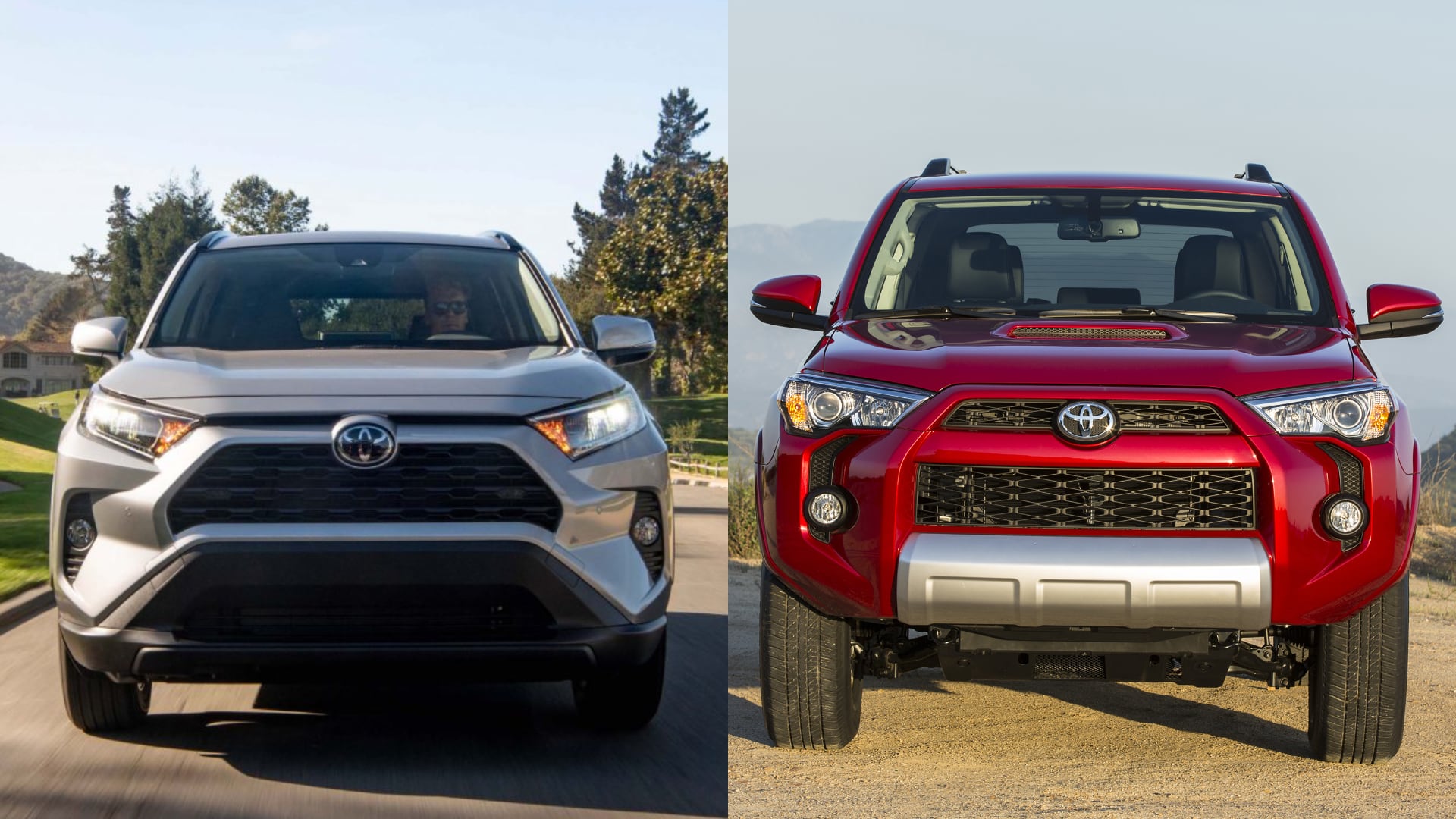As the most popular type of vehicle in North America, SUVs see fierce competition in the automotive marketplace. Car manufacturers everywhere are trying to balance great styling and features with utility and practicality.
SUVs invariably mean a larger financial investment, and so people want to feel as though they’re getting value for money. Today we’re taking a closer look at two popular Toyota SUV offerings, the Toyota RAV4 and the Toyota 4Runner.
Quick Summary
The Toyota RAV4 is a crossover SUV, which means it has the refinement of a passenger car but with extra practicality and increased ride height. The more expensive 4Runner is a traditional body-on-frame SUV, which makes it more capable off-road but comparatively clumsy on roads. It is available with a third row to seat up to 7, but its poor gas mileage makes it a poor choice as a family hauler.
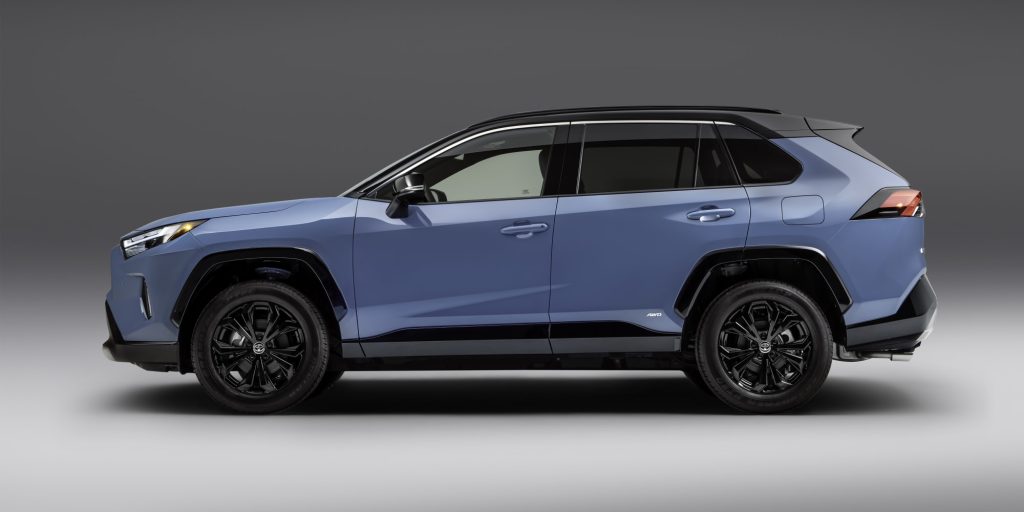
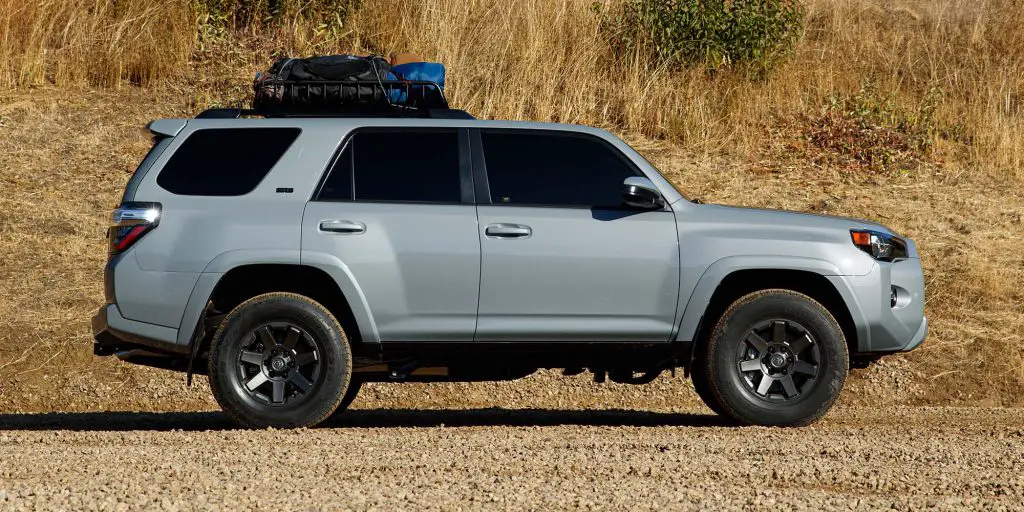
Pricing
The Toyota RAV4 starts at $26,525 for the base-level LE trim, and offers a whopping 11 further trims on top of that in a mixture of regular and hybrid powertrains. At the top of the pile is the Toyota RAV4 Hybrid Limited which starts at $37,575.
The Toyota 4Runner is the more expensive, but also larger of the two models. The base-level SR5 starts at $37,605, and builds up to the top-level TRD Pro trim, which starts at $52,420.
For budgeting then, it’s clear the RAV4 has the advantage since the starting price of the top trim level (and a hybrid model, at that) is cheaper than the base model of the 4Runner.
Exterior Styling
For exterior styling, those chasing a more contemporary and attractive look will find more to like in the design of the RAV4.
It has a more compact build. Sportier lines, an edgier and more aggressive front-end design and the sleek veneer of a truly modern SUV.
The 4Runner looks more akin to a large family SUV from the 1990s. It’s big, bulky, and ready for anything, but there’s little about it that says anything like the chic design of the RAV4.
That’s not to say the Toyota RAV4 is styled for pure city driving. With its roof rails and off-roading features, it can find great comfort and fun off-road as well as driving downtown.
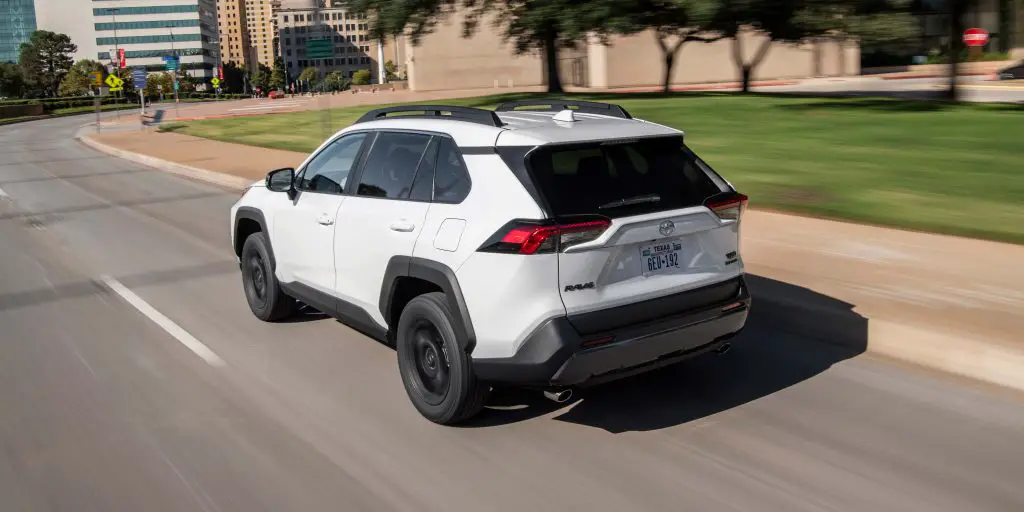
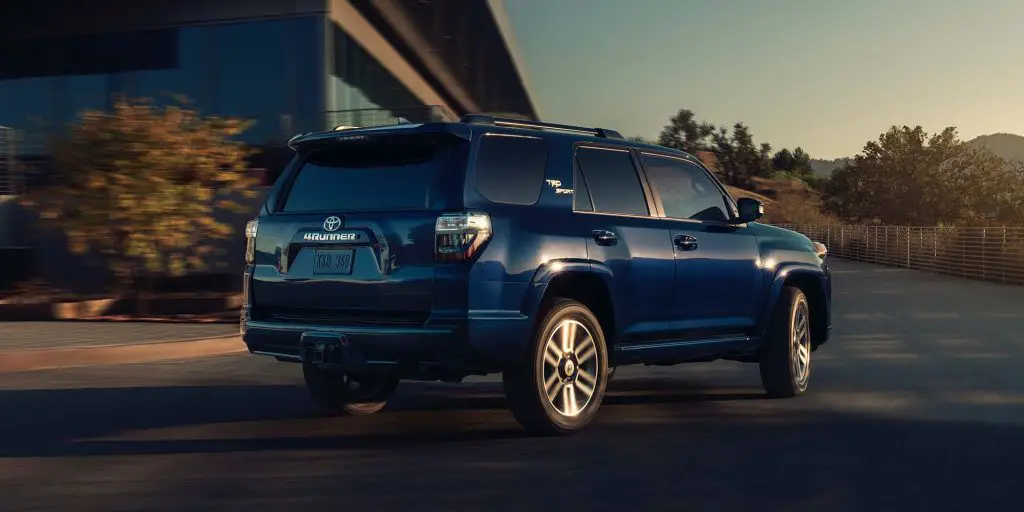
However, the 4Runner remains the more convincing when you’re thinking about adventure. The strong and square lines of the 4Runner make it look as though it could conquer any trail, any river, any mountain.
Interior
Both interiors are rather spartan if you stick to the lower trim levels, but as soon as you graduate your choice to the middle range of the trims, you get nice features, decent storage space and optional sunroof.
The Toyota RAV4 includes faux leather upholstery and leather-wrapped steering wheel, stitching and padding on the dashboard, a nice front center armrest and the minimum use of cheap plastics.
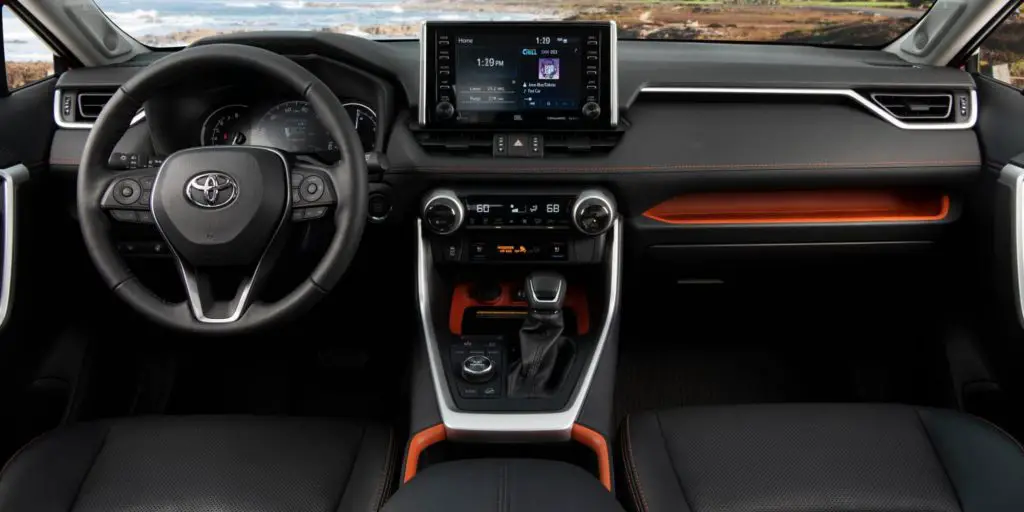
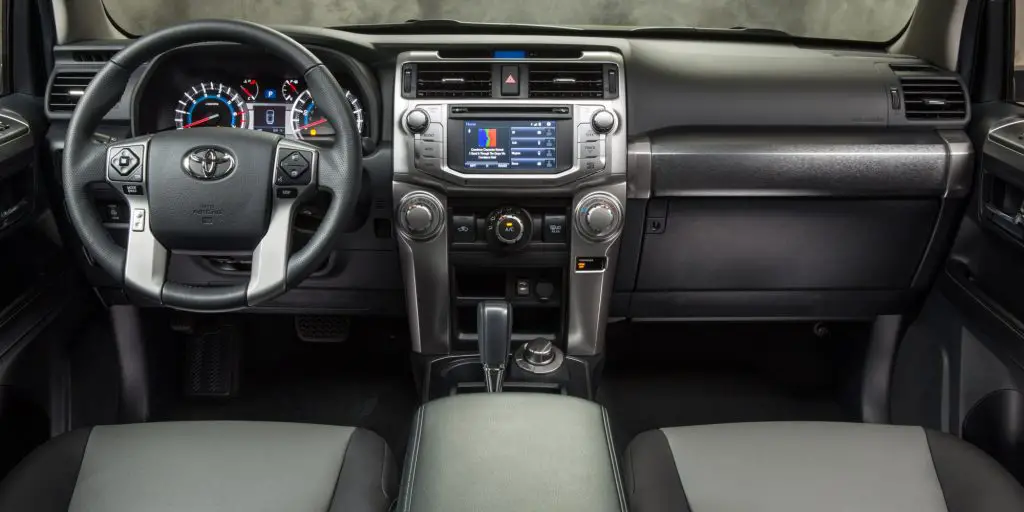
The Toyota 4Runner is about on par in terms of materials, but one can’t help but feel it’s all a little tired and dated. It’s a 2022 model but let’s not forget it’s still based on the 2010 fifth-generation model.
The 4Runner interior isn’t as roomy as you’d imagine, either, which is odd for an SUV of its apparent size. The second-row seats only have 32.9 inches of legroom. It does have an optional 3rd seating row, but this is really just an option for kids.
Performance
The RAV4 is loaded up with a 2.5L 4-cylinder engine delivering up to 203-hp and paired with an 8-speed automatic transmission and front wheel drive drivetrain as standard. AWD is offered on some trims, but not all.
The Toyota 4Runner contains a much larger 4.0L V6 engine paired with a 5-speed automatic along with RWD, part-time 4WD or full-time 4WD.
The 4Runner powertrain may sound more impressive with its 270-hp output, but it’s rather slow for road driving, getting from 0 to 60 in 7.7 seconds.
That’s not a great rating for what should be a powerful and capable V6 in an off-roading vehicle. The RAV4 has a smaller engine and isn’t engineered for massive power, but still manages 0 to 60 in 7.8 seconds, with some of the hybrid trims managing 7.4 seconds.
On the road, the RAV4 also offers more precise handling, and while the engine can get noisy when traveling at highway speeds, it holds its own well and feels secure, stable and comfortable on any road type.
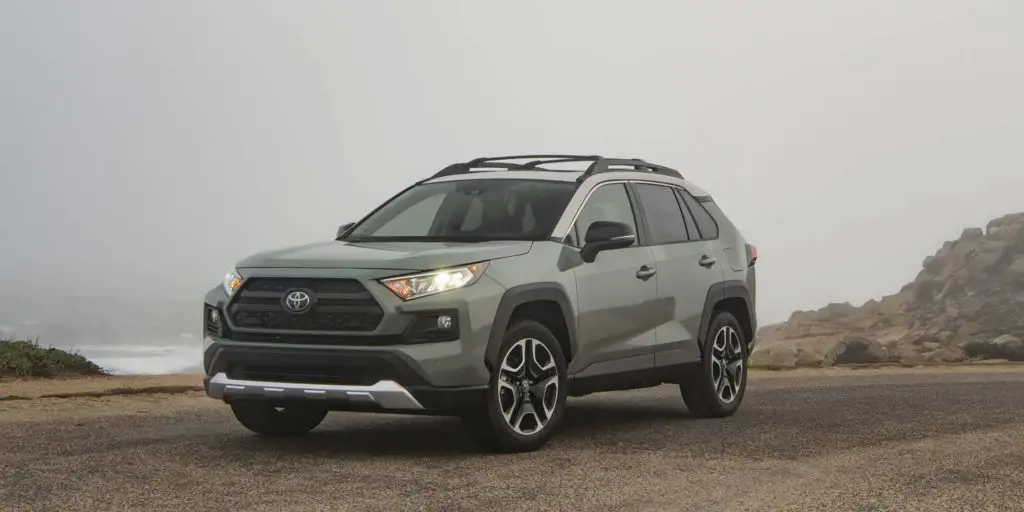
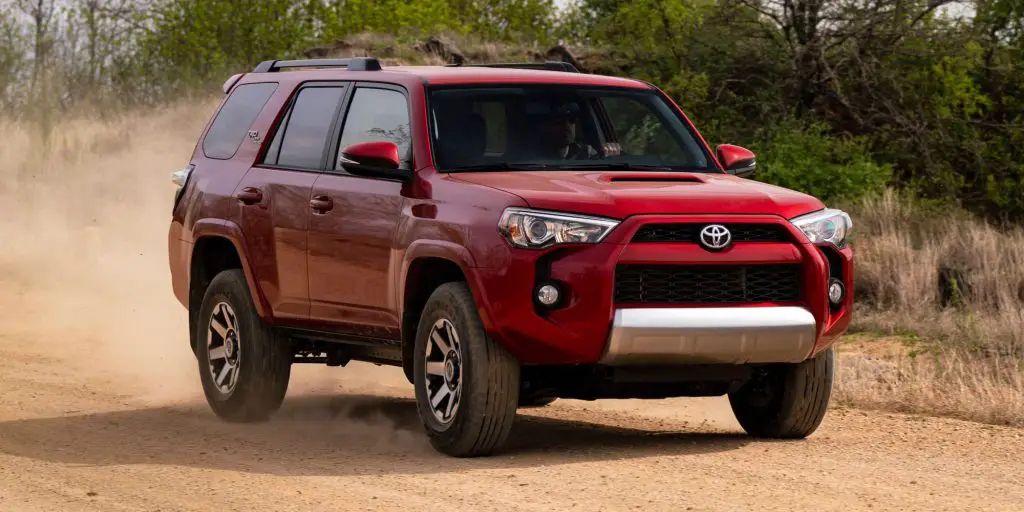
Off-Roading Capabilities
The Toyota 4Runner feels more clumsy on the road, but its impressive ground clearance, soft suspension, crawl control and locking rear differential make it an SUV capable of handling anything off-road with great aplomb. This is really what a true truck-based, body-on-frame 4×4 is all about. You lose the drivability of a crossover that drives more like a car, but gain greater off-roading capabilities. The Toyota Land Cruiser, Toyota Sequoia, Toyota Tundra, and Toyota Tacoma are other body-on-frame vehicles from the Japanese automaker.
The RAV4 can off-road, but it doesn’t generate the same amount of torque, have as much ground clearance, or have a transmission that’s set up for difficult terrain. This still applies to the ‘TRD Off-road’ version, which can’t match true 4x4s in terms of off-roading capability. The RAV4 is great, however, for dealing with harsh weather conditions or gravelly roads.
Practicality
The Toyota 4Runner offers the most cargo space if you don’t install the 3rd seating row. You get 46.3 cubic feet as standard, and up to almost 90 cubic feet with the rear seats down.
The RAV4 offers less cargo capacity, getting 37.5 cubic feet as standard, or 69.7 cubic feet with the rear seats down. If you often have a lot of kids in the car, the 3rd seating row option on the 4Runner does make sense and makes things a lot easier.
As for towing, the 4Runner once again blows the RAV4 out of the water with its capacity of 5,000-lbs compared to just a maximum of 3,500 on the RAV4.
Fuel Economy
This is one area where the Toyota RAV4 easily outshines the Toyota 4runner. The RAV4 is easily the most fuel-efficient, even more so when you opt for a hybrid powertrain.
The gasoline versions get 27-mpg in the city and 35-mpg on the highway (with the numbers being 41-mpg and 38-mpg respectively for hybrid models).
By comparison, the Toyota 4Runner gets 16-mpg in the city and 19-mpg on the highway at best.
Technology & Features
If you want more technology options, then we’d say the RAV4 has more for you, which is disappointing considering the price differences. The Toyota RAV4 now has an available 9-inch infotainment display, digital rear-view mirror, 7-inch multi-info display in the instrument gauge, and optional wireless charging pad. You can even lock and unlock the doors, and start the engine via your smartwatch.
The Toyota 4Runner has essential connectivity like Apple CarPlay, Android Auto and Alexa, and optional JBL premium audio, which is nice (but the RAV4 does too). Its best tech features are the TRD Pro additions that give it off-road capabilities, like TRD-tuned FOX high-performance shocks, Nitto Terra Grappler all-terrain tires, and added TRD accessories for off-road adventure. The optional 4WD features are also key for this.
Safety Features
Both models have Toyota Safety Sense, but the RAV4 gets a more up-to-date 2.0 version compared to the P version on the 4Runner. Both include a pre-collision system, pedestrian detection, dynamic radar cruise control (full-speed on the RAV4), and automatic high beams. The RAV4 did receive a better NHTSA rating of 5 stars compared to just 4 stars on the 4Runner.
Key Rivals
The RAV4 is a highly rated vehicle in the highly competitive compact SUV segment. Other popular models in this segment include the Ford Bronco, Hyundai Tucson, Honda CR-V, Mazda CX-5 and Volkswagen Tiguan.
Read more: Hyundai Tucson vs Honda CR-V comparison
Meanwhile, the outdated 4Runner finds itself relying on its off-roading capability and dependability alone against more modern/contemporary offerings in the Jeep Wrangler and Dodge Durango.
Verdict
The RAV4 appears in most ways to outmatch its more expensive Toyota counterpart. It has the looks, tech features, safety gear, and fuel-efficiency to be a great family hauler that’s more capable than your average car.
The 4Runner, however, does offer the 3rd seating row, more cargo capacity and stronger off-road capabilities.
As it stands, the RAV4 is the SUV most buyers should consider, unless they have off-roading needs. But even then, the 4Runner’s outdated build makes it difficult to recommend ahead of the likes of the Toyota Tacoma truck or second-hand Lexus GX.
Comparison Table
| 2022 Toyota RAV4 | 2022 Toyota 4Runner | |
|---|---|---|
| Trim | ||
| Price | $26525 | $37305 |
| Performance | ||
| Engine | 2.5L Inline-4 Gas | 4.0L V6 Gas |
| Horsepower | 203 hp @ 6600 rpm | 270 hp @ 5600 rpm |
| Torque | 184 lb-ft @ 5000 rpm | 278 lb-ft @ 4400 rpm |
| Transmission | 8-Speed Automatic | 5-Speed Automatic |
| Drivetrain | Front-Wheel Drive | Rear-Wheel Drive |
| Handling | ||
| Steering Type | Rack-Pinion | Rack-Pinion |
| Rear Suspension | Multi-Link | - |
| Rear Wheel Size | P225/65HR17 | P265/70SR17 |
| Front Suspension | Strut | - |
| Front Wheel Size | P225/65HR17 | P265/70SR17 |
| Turning Diameter (ft.) | 36.1 | 37.4 |
| Fuel Economy | ||
| MPG/MPGe - Hwy | 35 | 19 |
| MPG/MPGe - City | 27 | 16 |
| MPG/MPGe - Combined | 30 | 17 |
| Gas Tank Size (gallons) | 14.5 | 23.0 |
| Cruising Range - Hwy (miles) | 507.5 | 437.0 |
| Size and Weight | ||
| Height (in.) | 67.0 | 71.5 |
| Length (in.) | 180.9 | 190.2 |
| Weight (lbs) | 3370 | 4400 |
| Max Width (in.) | 73.0 | 75.8 |
| Wheelbase (in.) | 105.9 | 109.8 |
| Interior Dimensions | ||
| Seating Capacity | 5 | 5 |
| Front Seat Leg Room (in.) | 41.0 | 41.7 |
| Front Seat Head Room (in.) | 39.5 | 39.3 |
| Front Seat Hip Room (in.) | 54.3 | 56.5 |
| Front Seat Shoulder Room (in.) | 57.8 | 57.8 |
| Rear Seat Leg room (in.) | 37.8 | 32.9 |
| Rear Seat Head Room (in.) | 39.5 | 38.6 |
| Rear Seat Hip Room (in.) | 47.7 | 55.7 |
| Rear Seat Shoulder Room (in.) | 56.4 | 57.8 |
| Infotainment Features | ||
| HD Radio | Standard | Not Available |
| MP3 Player | Standard | Standard |
| WiFi Hotspot | Standard | Standard |
| Satellite Radio | Standard | Standard |
| Bluetooth Connection | Standard | Standard |
| Entertainment System | Not Available | Not Available |
| Premium Sound System | Not Available | Not Available |
| Auxiliary Audio Input | Standard | Standard |
| Smart Device Integration | Standard | Standard |
| Hard Disk Drive Media Storage | Not Available | Not Available |
| Interior Trim | ||
| Cloth Seats | Standard | Standard |
| Vinyl Seats | Standard | Standard |
| Leather Seats | Standard | Standard |
| Premium Synthetic Seats | Standard | Standard |
| Bucket Seats | Standard | Standard |
| Sun/Moonroof | Not Available | Not Available |
| Leather Steering Wheel | Not Available | Standard |
| Woodgrain Interior Trim | Not Available | Not Available |
| Comfort Features | ||
| A/C | Standard | Standard |
| Rear A/C | Not Available | Not Available |
| Telematics | Standard | Standard |
| Seat Memory | Not Available | Not Available |
| Seat-Massage | Not Available | Not Available |
| Keyless Entry | Standard | Standard |
| Keyless Start | Not Available | Standard |
| Cruise Control | Standard | Standard |
| Multi-Zone A/C | Not Available | Not Available |
| Power Liftgate | Not Available | Not Available |
| Climate Control | Not Available | Not Available |
| Head-Up Display | Not Available | Not Available |
| Power Mirror(s) | Standard | Standard |
| Automatic Parking | Not Available | Not Available |
| Navigation System | Not Available | Optional |
| Power Driver Seat | Not Available | Standard |
| Cooled Rear Seat(s) | Not Available | Not Available |
| Hands-Free Liftgate | Not Available | Not Available |
| Heated Rear Seat(s) | Not Available | Not Available |
| Remote Engine Start | Not Available | Not Available |
| Cooled Front Seat(s) | Not Available | Not Available |
| Heated Front Seat(s) | Not Available | Not Available |
| Power Passenger Seat | Not Available | Not Available |
| Remote Trunk Release | Not Available | Not Available |
| Heated Steering Wheel | Not Available | Not Available |
| Adaptive Cruise Control | Standard | Standard |
| Navigation from Telematics | Not Available | Not Available |
| Universal Garage Door Opener | Not Available | Not Available |
| Steering Wheel Audio Controls | Standard | Standard |
| Safety Features | ||
| ABS | Standard | Standard |
| Brake Assist | Standard | Standard |
| Night Vision | Not Available | Not Available |
| Rear Parking Aid | Not Available | Not Available |
| Traction Control | Standard | Standard |
| Stability Control | Standard | Standard |
| Blind Spot Monitor | Optional | Not Available |
| Cross-Traffic Alert | Optional | Not Available |
| Lane Keeping Assist | Standard | Not Available |
| Tire Pressure Monitor | Standard | Standard |
| Lane Departure Warning | Standard | Standard |
| Airbags | ||
| Knee Air Bag | Standard | Standard |
| Driver Air Bag | Standard | Standard |
| Seatbelt Air Bag | Not Available | Not Available |
| Passenger Air Bag | Standard | Standard |
| Rear Head Air Bag | Standard | Standard |
| Rear Side Air Bag | Not Available | Not Available |
| Front Head Air Bag | Standard | Standard |
| Front Side Air Bag | Standard | Standard |
| Warranty | ||
| Basic | 3 Years / 36,000 Miles | 3 Years / 36,000 Miles |
| Corrosion | 5 Years / Unlimited Miles | 5 Years / Unlimited Miles |
| Drivetrain | 5 Years / 60,000 Miles | 5 Years / 60,000 Miles |
| Maintenance | 2 Years / 25,000 Miles | 2 Years / 25,000 Miles |
| Roadside Assistance | 2 Years / Unlimited Miles | 2 Years / Unlimited Miles |
